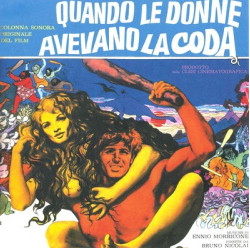主页--->m-comment-000--->mb-comment-010-97
|
电脑版 |
|||||||||||||||||||||||||||||||||||||||||||||
布罗克斯顿评说莫里康内 MB-010-97 |
||||||||||||||||||||||||||||||||||||||||||||||
FA7007 Quando le donne avevano la coda / When Women Had Tails / 有尾巴的女人 |
||||||||||||||||||||||||||||||||||||||||||||||
作者 乔纳森·布罗克斯顿 (Jonathan Broxton) |
||||||||||||||||||||||||||||||||||||||||||||||
ENNIO MORRICONE 评论,第10部分 010-97 |
||||||||||||||||||||||||||||||||||||||||||||||
 |
||||||||||||||||||||||||||||||||||||||||||||||
QUANDO LE DONNE AVEVANO LA CODA (1970年) 《Quando le Donne Avevano la Coda》是一部意大利性喜剧,由Pasquale Festa Campanile执导,背景设定在史前时代,当时“有尾巴的女人”并被穴居人猎杀。朱利亚诺·杰玛(Giuliano Gemma)饰演乌利(Ulli),她是在孤岛上长大的七个孤儿穴居人中的老大。在一场大火烧毁了他们所有的庄稼后,乌利带领他的兄弟们离开岛屿寻找新家,有一天在外出打猎时,他们遇到了美丽的“穴居女人”菲利(森塔·伯杰饰)。由于兄弟俩以前从未见过穴居女人,他们自然而然地想杀死并吃掉她——但菲利有其他想法,并试图利用她的“女性诡计”来勾引乌莉并挽救她的生命。 Quando le Donne Avevano la Coda 的配乐非常非常奇特。它有一个管弦乐队、I Cantori Moderni di Alessandroni 的合唱团,以及包括键盘、吉他、马林巴琴等在内的专业乐器,但对简单事实的描述并不能真正捕捉到乐谱的奇怪之处。主标题提示“Quando le Donne Avevano la Coda”以一种奇怪的柔和键盘节奏开始,莫里康内在其上分层了低沉、呱呱叫的男声说“啊哇”,一种呼吸的女声效果,以及一个奇怪的喜剧录音机主题,朗朗上口、漂亮而古怪,但当 70 年代轻盈的休闲摇滚编曲开始时,情况变得更加如此。这就是我非常喜欢莫里康内的原因——到底谁能为史前性喜剧想出这种声音组合?这真是太棒了;疯狂,出乎意料,如此聪明。 以此类推。“Nascita di Filly”以轻快的器乐基调为特色,以呼吸、略带色情的女声为特色,并以一些明亮的球状大号和弦为特色重现主旋律。“Can Can Delle Filly”是一首美妙的波萨诺瓦爵士乐曲,不可能不跳舞。“Marcetta dei Sette”是对竖笛和犹太人竖琴主旋律的重新演绎,听起来像是 La Moglie Più Bella 的疯狂表弟。“I Civettoni”听起来像是“Twinkle Twinkle Little Star”的变奏,与轻浮的古典小提琴独奏相得益彰。“Ulli, Grr, Malug, Put, Uto, 204, KAO”回归了“wa-wa-wa”的声音,只能被描述为 1960 年代迷幻悠闲的乡村音乐喜剧浪漫——也许? “Balletto Sulle Uova”是如此奇怪,以至于几乎无法描述,可以说像似器乐的放屁爆裂声。随后的“Pantomima Delle Caverne”在此基础上,在混音中加入了咕噜声,以及主旋律的不规则陈述,一个精致的音乐盒芭蕾舞序列。“Introduzione all'Introduzione di Una Introduzione”提供了康康主题的变奏,极具感染力,而结论性的“Preludio Alal Gioia”则缓慢建立,但最终成为一种舞蹈般的庆祝活动,将乐谱中许多独特的想法融合成一个充满活力的整体。整件事是如此欢快、乐观、愚蠢、俗气和善良,以至于你情不自禁地被它所吸引。 Quando le Donne Avevano la Coda 的配乐有几个版本,其中有几个版本将其与 1972 年续集 Quando le Donne Persero la Coda 的音乐配对,该音乐由 Bruno Nicolai 配乐。我在这里回顾的版本是 Contempo Records 发行的 11 首原创 LP 的 CD 重新发行,如果您想听一首在脸上露出愚蠢笑容的乐谱,同时惊叹于埃尼奥·莫里康内 (Ennio Morricone) 无尽的创造力,强烈建议您这样做。 曲目列表: 1. Quando le Donne Avevano la Coda (2:45), 2.Nascita di Filly (2:51), 3.Can Can Delle Filly (5:33), 4.Marcetta dei Sette (2:08), 5.奇维托尼一书(4:20),第6页。Ulli, Grr, Malug, Put, Uto, 204, KAO (3:44), 7.Balletto Sulle Uova (1:40), 8.Can Can Delle Filly #2 (4:02), 9.Pantomima Delle Caverne (3:04), 10.Introduzione all'Introduzione di Una Introduzione (1:16), 11.前奏曲 Alal Gioia (1:59).Contempo CD-2001,33 分 27 秒。 |
||||||||||||||||||||||||||||||||||||||||||||||
2021.2.13 |
||||||||||||||||||||||||||||||||||||||||||||||
|
| ||||||||||||||||||||||||||||||||||||||||||||||
以下是原文
| ||||||||||||||||||||||||||||||||||||||||||||||
ENNIO MORRICONE REVIEWS, Part 10-97 |
||||||||||||||||||||||||||||||||||||||||||||||
QUANDO LE DONNE AVEVANO LA CODA (1970) Quando le Donne Avevano la Coda – translated to ‘When Women Had Tails’ – is an Italian sex comedy directed by Pasquale Festa Campanile, set in pre-historic times when ‘women had tails’ and were hunted by cavemen. Giuliano Gemma plays Ulli, the eldest of seven orphan cavemen who grow up on an isolated island. After a fire burns all their crops, Ulli leads his brothers off the island to find a new home, and while out hunting one day they come across Filli (Senta Berger), a beautiful ‘cave-woman’. As none of the brothers have ever seen a cavewoman before, naturally, they want to kill and eat her – but Filli has other ideas, and tries to use her ‘feminine wiles’ to seduce Ulli and save her life. The score for Quando le Donne Avevano la Coda is very, very peculiar. It features an orchestra, the chorus of I Cantori Moderni di Alessandroni, and specialist instruments including keyboards, guitars, marimbas, and more, but that description of simple facts doesn’t really come close to capturing just how odd the score is. The main title cue, “Quando le Donne Avevano la Coda,” begins with a bizarre muted keyboard rhythms over which Morricone layers a deep, croaking male vocal saying ‘ah-wa,’ a breathy female vocal effect, and an oddly comedic recorder theme that is catchy and pretty and quirky, but then becomes even more so when the light 70s lounge rock arrangements kick in. This is what I love about Morricone so much – who on earth could have possibly come up with this combination of sounds for a prehistoric sex comedy? It’s just brilliant; insane, unexpected, so clever. And so on the score goes. “Nascita di Filly” features breathy, slightly erotic come-hither female vocals over a lilting instrumental base, and reprise of the main theme featuring some brilliant bulbous tuba chords. “Can Can Delle Filly” is a fabulous bossa nova jazz piece that it is impossible not to dance to. “Marcetta dei Sette” is a reworking of the main theme for recorder and Jew’s harp which makes it sound like the insane cousin of La Moglie Più Bella. “I Civettoni” sounds like a variation on ‘Twinkle Twinkle Little Star’ offset with a flirtatious classical violin solo. “Ulli, Grr, Malug, Put, Uto, 204, KAO” returns to the ‘wa-wa-wa’ voices in what can only be described as 1960s psychedelic laid-back country music comedy romance – maybe? “Balletto Sulle Uova” is so bizarre as to almost defy description, except to say that’s essentially instrumental farting and popping. The subsequent “Pantomima Delle Caverne” builds on this by adding grunting to the mix, as well as an off-kilter statement of the main theme, a dainty music box ballet sequence. “Introduzione all’Introduzione di Una Introduzione” offers a variation on the can-can theme which is wonderfully infectious, while the conclusive “Preludio Alal Gioia” builds up slowly but eventually becomes something of a dance-like celebration, blending many of the score’s unique and idiosyncratic ideas into a buoyant whole. The entire thing is just so cheerful and upbeat and silly and cheesy and good-natured that you can’t help but swept along by it. There are several versions of the soundtrack for Quando le Donne Avevano la Coda, several of which pair it with music from its 1972 sequel Quando le Donne Persero la Coda, which was scored by Bruno Nicolai. The version I have reviewed here is the CD re-issue of the 11-track original LP released by Contempo Records, and it comes highly recommended if you want to listen to a score which slaps a stupid smile on your face while you marvel at Ennio Morricone’s endless creativity. Track Listing: 1. Quando le Donne Avevano la Coda (2:45), 2. Nascita di Filly (2:51), 3. Can Can Delle Filly (5:33), 4. Marcetta dei Sette (2:08), 5. I Civettoni (4:20), 6. Ulli, Grr, Malug, Put, Uto, 204, KAO (3:44), 7. Balletto Sulle Uova (1:40), 8. Can Can Delle Filly #2 (4:02), 9. Pantomima Delle Caverne (3:04), 10. Introduzione all’Introduzione di Una Introduzione (1:16), 11. Preludio Alal Gioia (1:59). Contempo CD-2001, 33 minutes 27 seconds. |
||||||||||||||||||||||||||||||||||||||||||||||
Feb. 13, 2020 |
||||||||||||||||||||||||||||||||||||||||||||||
本站电影欣赏 |
||||||||||||||||||||||||||||||||||||||||||||||
在线音乐试听 |
||||||||||||||||||||||||||||||||||||||||||||||
|
||||||||||||||||||||||||||||||||||||||||||||||
 |
||||||||||||||||||||||||||||||||||||||||||||||
Jon 是一位电影音乐评论家和记者,自 1997 年以来一直担任全球最受欢迎的英语电影音乐网站之一 Movie Music UK 的编辑和首席评论员,并且是国际电影音乐评论家协会 (IFMCA) 的主席。在过去的 20多 年中,Jon 撰写了 3,000 多篇评论和文章,并进行了多次作曲家采访。在杂志刊物方面,乔恩曾为《电影配乐月刊》、《原声带杂志》和《电影音乐》等出版物撰写评论和文章,并为普罗米修斯唱片公司的两张经典 Basil Poledouris 配乐专辑《Amanda》和《Flyers / Fire on the Mountain》撰写了衬垫注释。他还为汤姆·胡佛 (Tom Hoover) 于 2011 年出版的《Soundtrack Nation: Interviews with Today's Top Professionals in Film, Videogame, and Television Scorering》一书撰写了一章。在1990年代后期,乔恩是伦敦皇家爱乐乐团的电影音乐顾问,并与他们合作拍摄了约翰·德布尼(John Debney)的音乐电影《相对价值》(Relative Values)和奥利弗·海斯(Oliver Heise)的音乐《佛陀的指环》(The Ring of the Buddha),以及与兰迪·纽曼(Randy Newman)合作的一系列音乐会。2012年,乔恩在波兰克拉科夫举行的第五届年度电影音乐节上担任“电影节学院”主席。他是作曲家和作词家协会的成员,该协会是作曲家、作词家和词曲作者从事电影、电视和多媒体工作的首要非营利组织。 |
||||||||||||||||||||||||||||||||||||||||||||||
2023.12.10 |
||||||||||||||||||||||||||||||||||||||||||||||
2023 手机版 |
||||||||||||||||||||||||||||||||||||||||||||||
|
||||||||||||||||||||||||||||||||||||||||||||||













